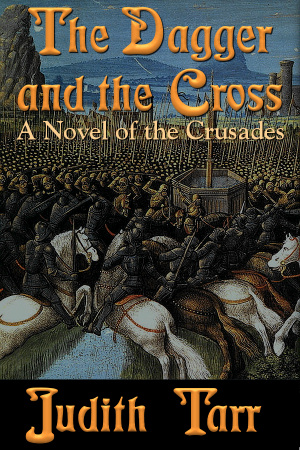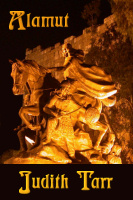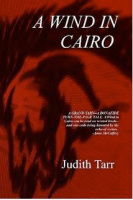The Dagger and the Cross (59 page)
Read The Dagger and the Cross Online
Authors: Judith Tarr

They linked arms, she and her mother. Their eyes met
briefly. Understanding; agreeing. Arm in arm, proper in their dignity, they
walked up from the quay.
The Horns of Hattin
The battle of the Horns of Hattin and the fall of the
Kingdom of Jerusalem seem made to order for the novelist. King Guy of Jerusalem
was much as I have shown him: a handsome man, a passable knight, and an inept
ruler. He seems to have been constitutionally incapable of making a decision,
unless it was the wrong one. He was badly overmatched by his adversary, the
sultan of Egypt and Syria, Salah al-Din Yusuf ibn Ayyub or, as the Franks
called him, Saladin.
For the events surrounding the battle, as well as for the
battle itself, I am indebted as always to M. C. Lyons and D. E. P. Jackson’s
Saladin:
The Politics of the Holy War
(Cambridge, 1982). I have taken certain
details of the battle, including the standard of Taqi al-Din, from Ian Heath,
Armies
and Enemies of the Crusades 1096-1291
(Worthing, UK, 1978). This book,
along with relevant volumes in the Osprey Men-at-Arms Series (particularly #75,
Armies of the Crusades,
and #171,
Saladin and the Saracens),
is
invaluable for the novelist as well as the wargamer.
The battle of Hattin broke the back of the Crusader Kingdom
of Jerusalem. Jerusalem itself fell at the end of September, 1187; on 2 October
the surrender was concluded.
By that time envoys had been sent to the West to preach the
new Crusade, led by, among others, Archbishop William of Tyre. They were
answered by Henry II of England and then, after his death, by his son and
successor, Richard I, as well as Philip of France and Frederick Barbarossa of
Germany. This, the Third Crusade, plagued by internal dissension, problems of
transport and supply, and such distractions and disasters as Richard’s conquest
of Cyprus and Barbarossa’s death on the march, failed of its end. Richard,
deserted by his allies, won back Acre but not Jerusalem. The city remained in
Muslim hands for almost eight centuries, until it was taken by British troops
in World War I.
The Crusader kingdom limped along for another century, until
its last outpost, the city of Acre, fell in 1291 to the armies of Islam. Guy de
Lusignan continued to call himself King of Jerusalem, to which, in 1192 and
until his death in 1194, he added the kingship of Cyprus. Conrad of Montferrat,
who managed to hold Tyre against Saladin, laid claim briefly to Guy’s crown; he
was murdered by Assassins in 1192, allegedly with the collusion of Richard of
England.
I have taken some liberties with the personality and history
of Guy’s elder brother, Amalric (Aymeric). He was in fact Constable of the
kingdom, named to that position by the leper-King Baldwin IV; it was he who
arranged the wedding of his brother to the Princess Sybilla. He himself had
married a great lady of the kingdom, Eschiva d’Ibelin; much later, in 1197, he
would take a second wife, Isabel de Courtenay, whose kinswoman, Agnes, was the
mother of Baldwin IV. In the end he fulfilled his royal ambition, inheriting
from his brother the title of King of Cyprus and, in 1197, that of King of
Jerusalem. From his capital of Acre he undertook by various stratagems to
incite a fourth Crusade.
The Fourth Crusade itself, by a concatenation of
circumstances to which only history can be subject—in fiction they would seem
preposterous—ended in the conquest not of Jerusalem but of Constantinople.
Amalric, who took no part in the actual, abortive Crusade, died in 1205. The
line of Lusignan continued to claim the kingship of Jerusalem until the final
fall of Acre.
The law of the Church in the twelfth century expressly and
repeatedly forbade the marriage of a Christian and an infidel. For a concise
historical and canonical summary, see Francis J. Schenk,
The Matrimonial
Impediments of Mixed Religion and Disparity of Cult
(Washington, DC, 1924).
The condemnation and threat of excommunication which Prince Aidan and his lady
receive in Chapter 8 is, if anything, mild in its phrasing. That such a
marriage was not regarded as completely unthinkable, however, is reflected in
the proposal of Richard of England that his sister Joanna be married to Saladin’s
brother. If the proposal had gone so far as to be acted upon, it would
certainly have required a dispensation from the pope. Equally certainly, only a
king, and a strong and determined one at that, could have hoped to gain so
extreme a concession.
The phenomenon of a forged dispensation is considerably less
unlikely. Forgery in fact was a high medieval art, often for exalted ends—a
notable
example is that of the so-called “Donation of Constantine,” which served as
support for numerous abrogations of temporal power by the papacy.
I am indebted to Sandra Miesel for an introduction to the intricacies
of medieval marriage law, as well as for the detail which signals the forgery,
namely, the suspension of the papal seal or
bulla
(hence the later
application of the term “bull” to all such papal documents) by a cord of either
silk or hemp, depending on the import of the document. See under “Bulls” in the
Catholic Encyclopedia;
see also “Bulla” in the
New Catholic
Encyclopedia.
Both are invaluable sources for details ecclesiastical and,
often, historical.
A final note for the meticulous: Pope Urban III (who died in
October 1187) was not in fact in Rome when my fictional king would have been
suing for the dispensation. He spent his papacy in Verona, judging the
political climate in Rome too hostile for safety. The five popes to whom the
petition was presented would be Popes Alexander III (1159-81), Lucius III
(1181-85), and Urban III, and Barbarossa’s antipopes Callistus (III) and
Innocent (III). Aidan, as a thoroughly medieval prince, would of course have
undertaken to cover all eventualities—and all possible claimants to the papacy.
The Dagger and the Cross
A Novel of the Crusades
Judith Tarr
Book View Café
August 2011
Copyright © 1991, 2011 Judith Tarr
ISBN: 978 1 61138 073 6
Cover design by Pati Nagle
First published by Doubleday Foundation
v420110930vnm
Book View Café

Book View Café
is a professional authors’ cooperative offering DRM-free ebooks
in multiple formats to readers around the world. With over thirty authors in a
variety of genres including mystery, romance, fantasy, and science fiction,
Book View Café has something for everyone.
Book View
Café
is good for readers because you can enjoy high-quality DRM-free ebooks
from your favorite authors at a reasonable price.
Book View
Café
is good for writers because 95% of the money received goes
directly to the book’s author.




